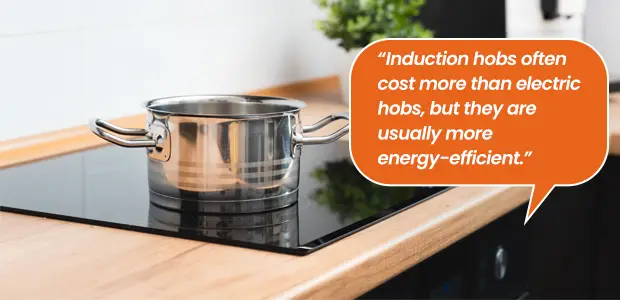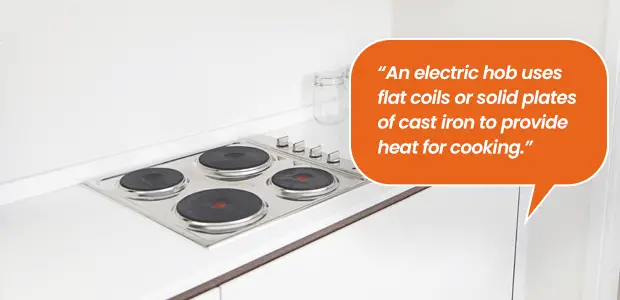The similarities of an induction hob vs electric hob can often cause some confusion when trying to choose the best one for your kitchen.
In some respects, they have features that make them both perform equally well. But it’s in learning about their differences that your decision may soon be made easier.
Here’s what you should know when deciding between an induction hob or electric hob.
[lwptoc title=”Table of Contents” hideItems=”1″]
What is an Induction Hob?
When you consider induction hob vs electric hob, you’ll need to understand what an induction hob is and how it works. It has become one of the latest kitchen innovations even though the principles of induction cooking were developed by the American Westinghouse Electric Corporation at the beginning of the 1970s.

An induction hob uses an electromagnetic circuit to provide heat. Once activated, the extensive coils of copper wire beneath the hob’s surface produce an electromagnetic field. It enables the energy it produces to transfer directly to a pan placed on the hob.
The electromagnetic circuitry causes the ingredients inside the pan to vibrate at an imperceptible, but intense rate. In effect, the motion enables the food to create its own heat to cook.
Induction Hob Pros and Cons
As with any kitchen appliance, there are a few pros and cons to consider when choosing between an induction hob and an electric hob!
- Energy Efficiency – An induction hob is ideal for reducing your kitchen’s carbon footprint. The electromagnetic system is usually inexpensive to run, helping to reduce your fuel bills. It uses just enough electricity to activate the electromagnetic system. Only the pan base is heated, regardless of its size in relation to the burner. An induction hob generally achieves an energy efficiency of around 90%.
- Electromagnetic System – Induction cooking uses electromagnetic technology to transfer heat by creating its own energy. It works through the electromagnetic field causing the minuscule atoms in pans and food to oscillate. As they move back and forth, they produce heat. It avoids wasting the energy that’s always lost when pans don’t entirely cover the burner.
- Safe Surface – Electromagnetic induction cooking has a good record regarding safety. The system only heats the area with a pan and never the whole hob. Even if you have a pan that’s fiercely boiling, the surrounding ceramic glass of the hob should always remain cool. It should be a much safer method of cooking if you have inquisitive children or pets.
- Easy Clean – The ceramic glass surface of an induction hob is attractively designed and should enhance any fitted kitchen. It’s also easy to maintain. Any spillages falling on the stay-cool surface won’t continue cooking, helping to avoid those stubborn burnt on scraps of food. All you need to do is wipe the hob regularly with a damp cloth.
- Expensive Purchase – The advanced technology of the induction hob makes it a much more expensive investment than an electric hob. But over an average lifespan of fifteen years, it can potentially save you a great deal of money on running costs.
- New Pans – Every pan used on an induction hob must contain magnetised metal in its base. If you’re upgrading from a traditional gas hob you might need to upgrade to induction compatible pans.
What is an Electric Hob?
The electric hob has been in use for much longer than the induction hob. It was invented in 1882 by Thomas Ahearn of Canada. But due to the slow introduction of electricity into average homes, the electric hob didn’t become popular for another fifty years. An electric hob uses flat coils or solid plates of cast iron to provide heat for cooking.

Older electric hobs usually had the rings exposed on the surface. Some designs have been improved by a solid plate cover. More expensive electric hobs now include a full ceramic glass cover to add a stylish appearance and make them easier to use.
Whichever design the electric hob has, a ring or plate becomes hot and the heat it produces gradually cooks the ingredients inside the pan.
Electric Hob Pros and Cons
Just like an induction hob, there are a few electric hob pros and cons you should be aware of!
- Budget Conscious – Whatever your budget, there should be an affordable electric hob you can buy. A hob with coiled rings on the surface is the cheapest. You can even make it look more attractive and streamlined when it’s not in use. Simply invest in a stylish, but inexpensive, hob cover. An intermediate price includes an electric hob with burners made of iron discs. Top of the range electric hobs usually have ceramic glass surfaces that look identical to an induction hob.
- Model Range – Electric hobs offer a much greater choice of designs. There are traditional style hobs with manual knobs up to sophisticated electric hobs with Smart control. Installation for an electric hob of any design is usually quicker and less expensive than an induction hob.
- Residual Heat – Electric burners absorb heat so well that they take a few minutes to start cooling down once you’ve switched them off. You’ll save energy and money by timing your cooking to make the best use of this leftover heat. Turn off the burner part of the way through a cooking task such as boiling eggs and leave the residual heat to finish the job without using further energy.
- Versatile for Pans – Electric works well with any type of cookware. Aluminium is one of the most effective heat conductors. Stainless steel and copper should also produce excellent results. They don’t have to be magnetised with iron to work with an electric hob as they would on an induction hob.
- High Running Costs – Electric hobs are much more expensive to run than any other method of cooking. An electric hob generally has an energy-efficiency rate of approximately 65%. Much of the wasted energy can be lost through mismatched pan to burner sizes or not taking care to use the residual heat wisely.
- Hot Surface – The burners of any type of electric hob stay hot for a long time after you’ve turned them off. The surrounding area of the hob also becomes very hot whenever you cook. Unless you are vigilant, young children in particular can burn their fingers on the hot edges of an electric hob.
Induction Hob vs Electric Hob – Are they the same?
There are similarities when you analyse electric hob vs induction hob, but it depends on which models you consider. If you choose an electric hob with a ceramic glass surface, it will look identical to an induction hob.

The aesthetic design of each type is equally appealing and should provide your kitchen with a modern, sophisticated elegance. The hobs also have to be fitted into your kitchen worktop. You will also need an electricity supply for both types of hob, although for the induction hob, it’s only to activate the electromagnetic field.
When considering the controls of an induction hob vs electric hob, you’ll often find models for each with easy to use touch screen controls.
Smart Technology for Induction Hob vs Electric Hob
Kitchen technology has enabled appliances to be integrated with smart home automation systems. Superior designs for induction hobs and electric hobs incorporate Smart capability, enabling you to control your hob through a Smartphone app.
Energy Efficiency
An electric hob needs a constant flow of electricity to cook your food. It has an estimated energy efficiency of around 65%. Pans rarely form a precise match for the heating element, which results in wasted heat escaping into your kitchen.
Each burner also produces residual heat once you have turned it off due to the heated ring or plate needing several minutes to cool down. You can often use this surplus warmth to finish cooking food or to keep it warm until serving, but you have to get your timing right.

An induction hob only requires a tiny amount of electricity to activate the electromagnetic system. It usually achieves an energy efficiency of 90%. The induction hob’s burner or element is only active when a suitable magnetised pan is in place to directly draw energy up from the electromagnetic field.
When you use pans up to the maximum size of the cooking zone, it doesn’t matter if it’s not an exact match. The electromagnetic energy is only active where it’s in direct contact with the pan, resulting in minimal wastage of heat. As soon as you remove a pan or turn the cooking zone off, the induction hob is immediately cool.
How Safe is the Surface – Electric Hob vs Induction Hob?
An electric hob always becomes hot when the burners are switched on. The elements also retain heat for several minutes. You must always keep a hot burner safe by placing a spare pan on it to prevent anyone from touching it. However, you must also remember to add some water to the pan otherwise it will simply burn.

An induction hob’s technology allows the concealed cooking zones to always stay cold. The electromagnetic circuitry only transfers heat to the inside of the pan and doesn’t heat the hob itself. You can remove pans at any time without having to wait for the hob’s surface to cool.
Do the Hobs use the same Pans?
An electric hob uses any type of pan, including aluminium, stainless steel and copper. Induction hobs must use pans with a magnetic base of ferrous metal. Fortunately, many modern pans incorporate layers of ferrous, carbon steel, making them a versatile choice. If your pans are old, you may need to purchase a new set.
Conclusion
An electric hob with a ceramic glass surface may look identical to an induction hob. They might also both include Smart control. However, the way the hobs operate is vastly different. Induction hobs often cost more than electric hobs, but they are usually more energy-efficient, saving money long-term.
